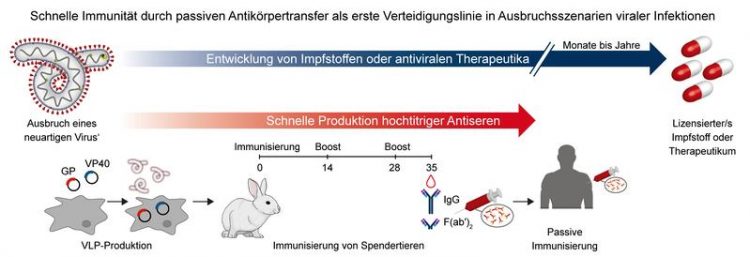Ebola, Nipah, and ???: ’Plug-and-Play’ for the rapid production of protective antibodies

Immediate Immunity provided by passive antibody transfer as a first line defence in outbreak of emerging infections PEI
Outbreaks of infectious diseases can sometimes reach epidemic proportions, such as the large Ebola virus outbreak in Western Africa in 2014, which resulted in more than 28,500 infections and 11,000 deaths.
A new Ebola outbreak in the Democratic Republic of the Congo is currently being fought. Nipah and Hendra viruses are examples of other dangerous pathogens, which have thus far caused only minor outbreaks, such as the Nipah outbreak ongoing in India.
Effective vaccines against known pathogens have been available for many years. However, in the event of an outbreak with new life-threatening pathogens, therapeutics are needed that can be produced very quickly for many people and provide protection until a vaccine becomes available. Passive immunisation, the administration of convalescent plasma containing specific functional antibodies, provides a straight forward way to treat infected individuals.
Here one makes use of the fact that during an infection, antibodies are produced by the immune system and then circulate in the blood of the convalescent patient. The convalescents' blood plasma, which contains sufficient levels of neutralising antibodies against the specific pathogen, can then be administered to newly infected patients and protect them from disease, or at least prevent severe outcomes.
However, convalescent plasma is often scarce, since only individuals who have already recovered from the disease can serve as donors. Here the production of hyperimmune sera in animals constitutes an attractive alternative. Researchers at Paul Ehrlich Institute led by Prof. Veronika von Messling, Director of the Division of Veterinary Medicine, have collaborated with researchers from the Universities of Marburg and Munich as part of the German Center for Infection Research (DZIF) using Ebola and Nipah viruses as models to investigate how the production of functional antibodies in rabbits can be induced as effectively as possible.
The researchers found that adjuvanted virus-like particles (VLPs) efficiently stimulated the production of functional antibodies at high titers in animals. VLP-based vaccines are particularly interesting because the immune system recognises them as virus particles, but VLPs do not multiply in target cells.
The high antibody titres observed here indicate that de novo antigen expression is less important for the production of functional antibodies than the presentation of the antigen in its natural form. With an optimised purification process, concentrated polyclonal antibodies were obtained that were stable in vivo.
Such polyclonal antibody concentrates have the advantage to be directed against different sites (epitopes) of the pathogen, so there is less risk of loss of function due to mutations in the virus compared to monoclonal antibodies which are directed against only one epitope.
Nipah VLPs were also able to induce the production of high-titre functional antibodies. VLPs can be produced in sufficient quantities for the immunisation of animals within one to two weeks, and can be produced for different pathogens, so that they could potentially be used as a convenient plug-and-play system for antibody production.
“We consider the production of polyclonal antibodies using pathogen-adapted adjuvanted VLPs a promising approach for the rapid delivery of protective immune sera in the event of outbreaks of new dangerous viruses”, says Dr. Veronika von Messling in explaining the research team’s results.
Press Office
Phone: +49 6103 77 1030
Email: presse@pei.de
SchmidtR, Beltzig LC, Sawatsky B, Dolnik O, Dietzel E,
Krähling V, Volz A, Sutter G, Becker S, von Messling V (2018): Generation of therapeutic antisera for emerging viral infections. NPJ Vaccines. 2018 Okt
NPJ Vaccines 3, Article number: 42 (2018) https://doi.org/10.1038/s41541-018-0082-4
https://www.pei.de/EN/information/journalists-press/press-releases/2018/21-ebola…
Media Contact
All latest news from the category: Life Sciences and Chemistry
Articles and reports from the Life Sciences and chemistry area deal with applied and basic research into modern biology, chemistry and human medicine.
Valuable information can be found on a range of life sciences fields including bacteriology, biochemistry, bionics, bioinformatics, biophysics, biotechnology, genetics, geobotany, human biology, marine biology, microbiology, molecular biology, cellular biology, zoology, bioinorganic chemistry, microchemistry and environmental chemistry.
Newest articles

A ‘language’ for ML models to predict nanopore properties
A large number of 2D materials like graphene can have nanopores – small holes formed by missing atoms through which foreign substances can pass. The properties of these nanopores dictate many…

Clinically validated, wearable ultrasound patch
… for continuous blood pressure monitoring. A team of researchers at the University of California San Diego has developed a new and improved wearable ultrasound patch for continuous and noninvasive…

A new puzzle piece for string theory research
Dr. Ksenia Fedosova from the Cluster of Excellence Mathematics Münster, along with an international research team, has proven a conjecture in string theory that physicists had proposed regarding certain equations….



